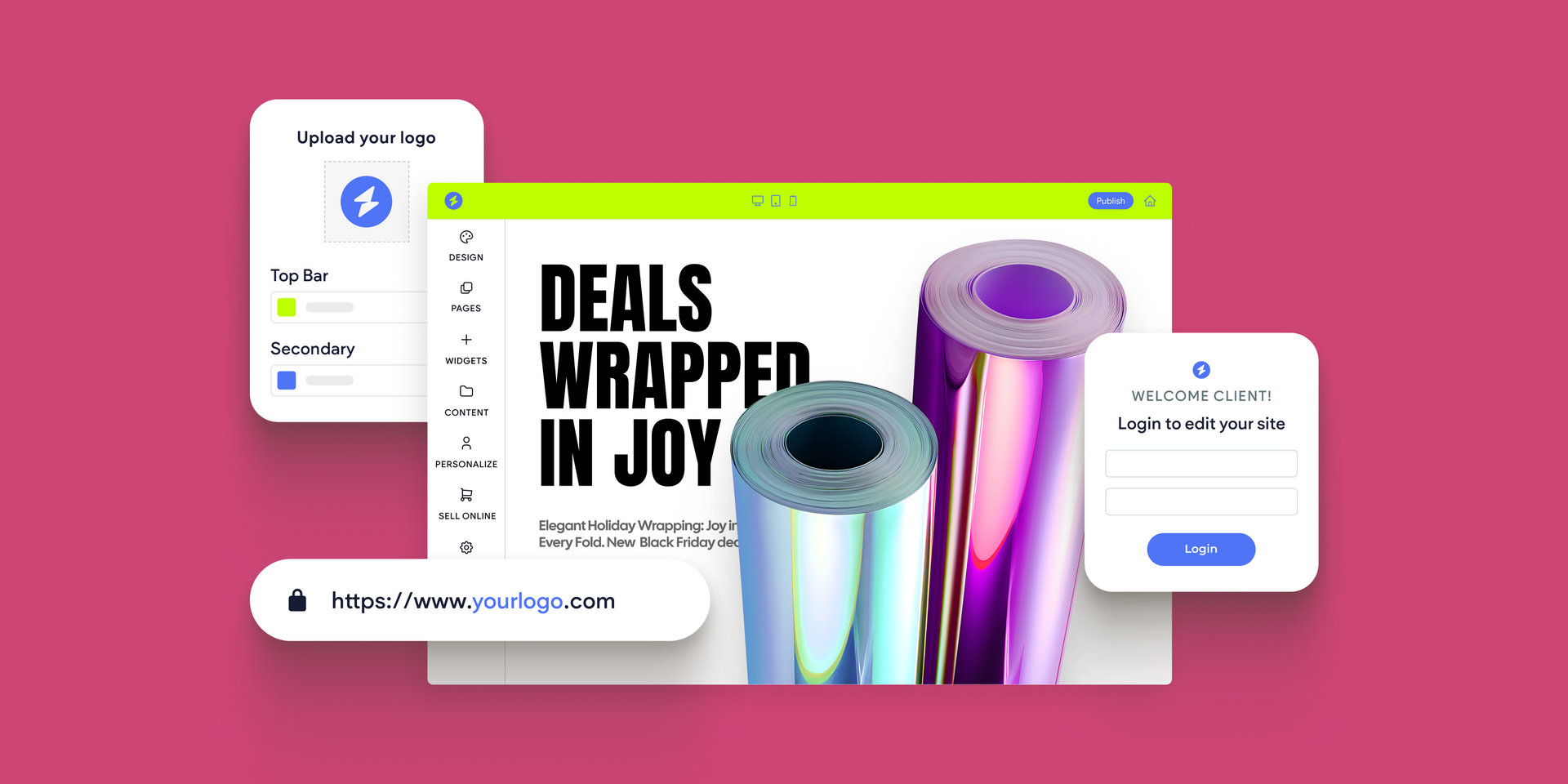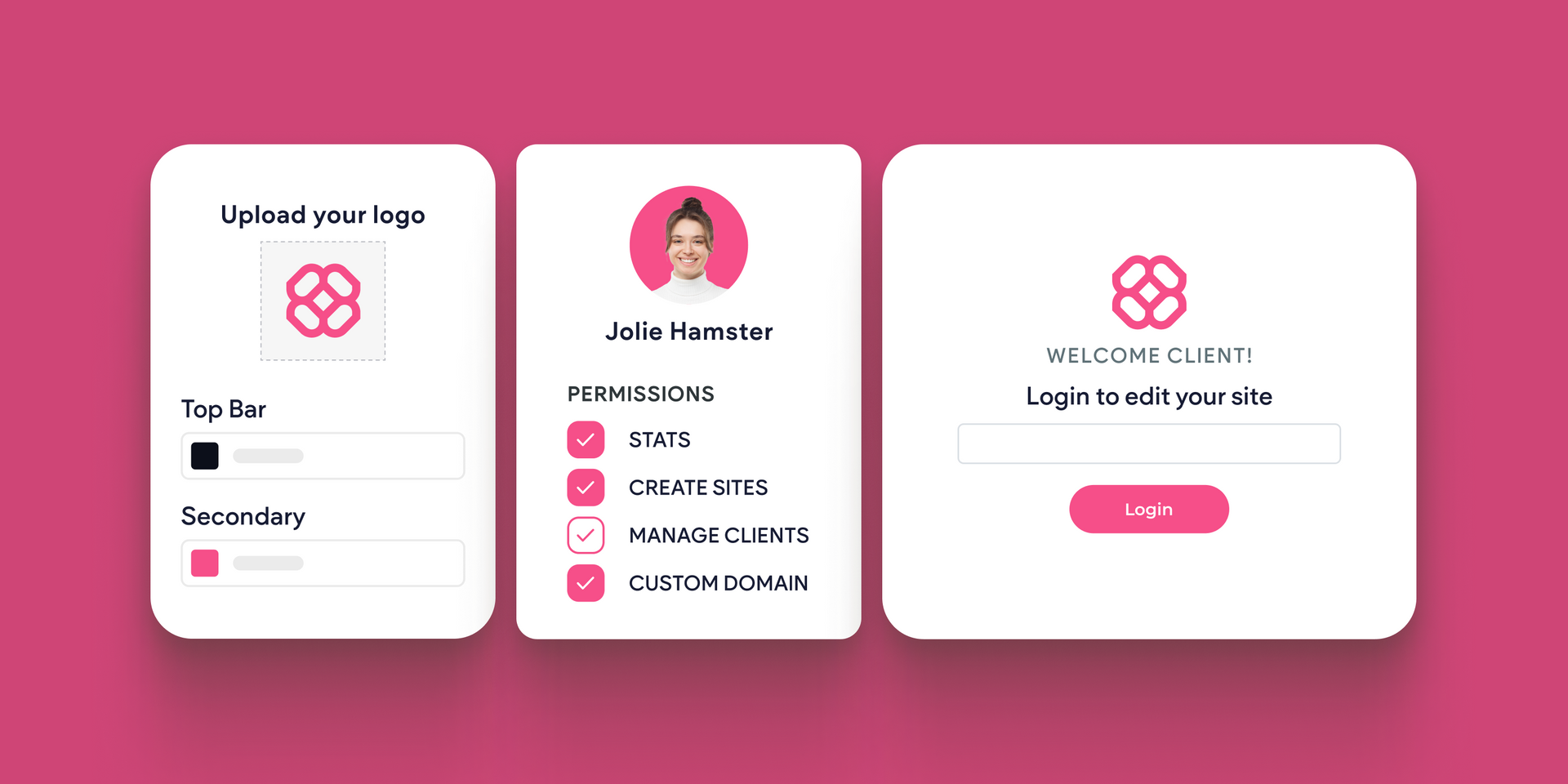In the
agency world, including
white-label products or services has become one of those things that every agency is considering, or has already considered (if not currently using). If you're one of the few agencies that haven't yet taken this path and are experiencing a bit of FOMO, keep reading.
As a white-label website builder specifically designed for agencies, we wanted to take this opportunity to explore the reasons why we feel incorporating a white-label offering is not just promising but, in many cases, imperative and strategic for marketing agencies aiming to thrive in today's dynamic marketing ecosystem.
But before we delve deeper, let's ensure we're all on the same page by starting with a straightforward definition of white-label products.
What are white-label products or tools?
White-label products refer to goods or services produced by one company but sold by another under a different brand name. Essentially, these products are created to be easily rebranded and resold by other businesses as if they were their own.
In the context of marketing agencies, white-label products offer a unique and strategic solution to address various client needs without the agency having to invest extensive resources in developing these products in-house, allowing marketing agencies to focus on their core competencies while delivering a comprehensive range of solutions to their clients. For example, a white-label website builder, like Duda, offers agencies the ability to build clients' sites, under the agency’s brand; the CMS is branded, including the client login screen and there’s even a branded support portal for client’s queries.
Now that we've covered what white-label products are, let's take a look at the kinds of products that can be white-labeled for marketing agencies.
Related:
Top 9 White Label Tools For Agencies
What types of products or services can be white-labeled?
The versatility of white-label solutions makes them applicable across a broad spectrum of products and services, catering to the diverse needs of marketing agencies and their clients.
Let's explore some key white-label products that empower marketing agencies to elevate their offerings and deliver exceptional value to clients:
- SEO:
Offering SEO services to enhance online visibility and rankings like SEO audit, reporting, and optimization, under the agency’s brand.
- PPC:
Deliver targeted and results-driven online advertising campaigns through white-label PPC solutions.
- Email Marketing: Personalize client communication with white-label email marketing tools.
- Social Media Management: Streamline social media presence with white-label tools for scheduling, engagement, and analytics.
- Web Design and Development:
Offer professional and responsive websites through a white-label website builder.
- Content Marketing: Deliver engaging and relevant content to target audiences using white-label content marketing solutions.
- CRO (Conversion Rate Optimization):
Optimize websites for increased conversion rates through white-label CRO services.
And the list goes on…
Why are white-label solutions a valuable asset for agencies?
Choosing white-label products and services isn't just a matter of convenience; it's a strategic move that unlocks a myriad of advantages for marketing agencies:
- Brand Consistency -
White-label products are seamlessly integrated into your agency's brand. That's their forte: ensuring consistency across your offerings and reinforcing your agency's identity in the market. Clients will recognize and associate the quality and expertise of your brand with the diverse range of services you provide, building a stronger and more cohesive brand image and reputation. Moreover, branding translates to revenue -
a survey conducted by Lucidpress and Demand Metric revealed that maintaining consistent brand presentation across various platforms has the potential to boost revenue by as much as 23%!
- Comprehensive solutions - Clients often seek convenience and a comprehensive suite of services from a single provider. By integrating white-label solutions into your agency's offerings, you position yourself as a one-stop solution for your clients. This not only strengthens your client relationships but also enhances customer loyalty, as they can fulfill multiple needs through a trusted and familiar source.
- Competitive offerings alignment - Staying competitive in the marketing industry requires keeping pace with the latest standards. White-label solutions allow your agency to match or exceed your competitors' offerings without the need for extensive research and development. This ensures you stay relevant in a rapidly evolving landscape and maintain your position as a leader in the market.
- Service expansion:
Diversifying your service portfolio is a key strategy for agency growth. White-label products enable you to expand your offerings and cater to a broader range of client needs.
- Improve quality of service:
White-label solutions are often developed by experts in their respective fields. By incorporating these products into your service lineup, your agency can leverage the expertise of specialists without the need to hire additional staff. This ensures that the services you provide are of the highest quality, meeting or exceeding client expectations and solidifying your reputation as a top-tier marketing agency.
O.k, so the benefits are quite straightforward, but are there any considerations to take into account?
What to consider before choosing a white label tool?
There are many factors to take into account to ensure you select a solution that aligns seamlessly with your agency's needs and goals. While this is true when choosing any generic tool, it's especially important when selecting a white-labeled tool that will represent your agency’s brand.
Here are key considerations:
- Level of support - Evaluate the support offered by the white-label tool provider. Top-level support ensures you have assistance when needed, minimizes downtime, and addresses any issues promptly. Remember, the level of support you’ll receive is also the level of support your clients receive, so make sure you opt for a tool that offers top-notch support for both you and your clients.
- Security-
Security breaches and issues are the worst, especially when you're the one taking the fall for them. Do your diligence and make sure your chosen tool adheres to industry standards and regulations, safeguarding both your agency's and your clients' sensitive data. Robust encryption and comprehensive security protocols are non-negotiable.
- Customization -
Assess the level of customization the white-label tool allows. The ability to tailor the tool to match your brand identity and specific client requirements enhances its effectiveness and integration into your service offerings.
- User experience - It's likely that not only you but also your clients will be using the tool. An easy-to-navigate interface contributes to overall efficiency and client satisfaction. Also, be sure to check that the tool provides adequate training, walkthroughs, and documentation.
- Look & Feel - We've addressed the branding issue – your chosen tool should offer the flexibility to reflect your agency's aesthetics. Consistency in the look and feel, along with the ability to align with your branding elements, enhances a cohesive client experience. However, another crucial aspect is the visual appeal of the tool itself. If the tool lacks a sleek and modern appearance, it may project an outdated image onto your agency.
- Maintenance -
Examine the maintenance requirements of the tool. A tool that demands minimal upkeep allows your agency to focus on delivering quality services rather than grappling with constant maintenance. Regular updates and support should be part of the package.
- Client management and team collaboration capabilities -
Regardless of the tool's core functionality, you want to make sure it also includes features for client management and team collaboration, as these features will streamline your operations and essentially make your, your team's, and your clients' lives easier.
- Innovation and updates - Being part of the marketing world, you always want to be associated with innovation, so be sure to check how often the tool you are considering is updated and improved and that it keeps up with industry standards, guaranteeing your association with a cutting-edge solution in the ever-evolving landscape of marketing.
Duda white label website builder - A game changer for agencies
When discussing website builders specifically (since we are one), in the context of agencies, white labeling is essential. It’s much harder to churn from your agency if the client is used to YOUR website builder and has grown accustomed to it. Moreover, clients don’t care for website maintenance; it is perceived as a lot of work. If it’s your website builder, they’ll become entirely dependent on you to maintain their website, and you can use this to keep them engaged with your agency or even upsell maintenance packages.
Although there are other website builders out there that offer white-label features (to some extent), Duda is the most advanced white-label website builder for agencies. Why? First and foremost, it’s because Duda was built with agencies in mind, so its white-label offering is prominent, providing a comprehensive solution that caters to agencies of all sizes. Aware of agencies' challenges and requirements, we tailored our white-label capabilities to suit the specific needs of agencies, ranging from a branded CMS and email communications right down to a branded support portal for clients.
Here is a detailed overview of Duda’s white-label features:
- Client login screen -
Your clients gain entry through a personalized white-label login screen adorned with your branding, ensuring a seamless and branded experience.
- Branded CMS - Take full control of the Duda website builder by incorporating your logo, brand colors, and a custom domain name for a distinctly branded appearance.
- Site preview capabilities - Empower clients with interactive site previews, allowing them to visualize how their website will appear across desktop, tablet, and mobile devices.
- Roles and permissions management - Fine-tune client access by choosing which features they can utilize and grant specific permissions to your team members for more precise control.
- Client-focused dashboard -
Provide clients with a user-friendly white-label dashboard, offering them the ability to manage their websites, view statistics, and more, all under your brand.
- Template gallery access - Grant clients access to Duda’s extensive library of captivating website templates, all presented under your brand (API access is required for this feature).
- Branded email communications - Deliver branded emails prompting clients to log in, reset their passwords, and review weekly or monthly statistics for a consistent brand experience.
- Client support portal -
Offer clients a 24/7 branded support portal, eliminating the need for a large team to handle tickets while maintaining a cohesive brand presence.
- Comprehensive video library -
Leverage a rich collection of tutorials, all featuring your brand, to showcase value, address support issues, and expedite client onboarding.
- Marketing resources - Access a range of sales collateral easily customizable with your brand, from sales decks to handouts, to enhance your marketing efforts.
- Client Billing integration -
Streamline the collection of payments, both one-time and recurring, through the Duda platform, all presented under your brand for a unified billing experience.
In addition, Duda's platform aligns with the essential considerations outlined earlier.
Duda places a strong emphasis on the 'behind the scenes' aspect, with customer service taking a central role to ensure agencies and their clients receive top-level assistance. Security and maintenance are also paramount focuses, as Duda's platform provides clients with unmatched stability, allowing them to benefit from automatic SSL, AWS hosting, and a guaranteed 99.9% uptime. The platform is crafted with minimal maintenance requirements, empowering agencies to concentrate on delivering quality services rather than dealing with updating plugins or addressing security breaches and downtimes. The front stage is equally a priority at Duda, featuring an intuitive, sleek interface designed for both agencies and clients. Regular updates keep the product looking fresh and modern, positioning Duda at the forefront of innovation (make sure to explore our
AI Assistant tool).
Want to get a taste of Duda and experience all that it has to offer?
Start a free trial.
Final Note
Embracing white-label products is not just a trend but a strategic decision that can propel your agency to new heights in the competitive landscape of the marketing industry. The numerous benefits make white-label solutions a valuable asset for agencies looking to thrive and remain at the forefront of innovation.








